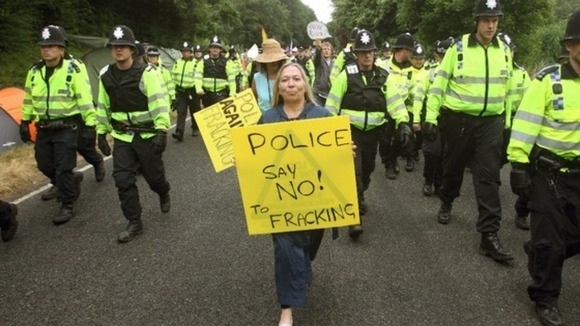“Dear Aunty, will fracking for shale gas deplete our drinking water supplies?”
Well, sweeties, it’s true that hydraulic fracturing uses a lot of water – a topic I’ve posted on before here – but, seen in the context of other industrial uses of water and pipeline losses, it really isn’t all that great and is very unlikely to limit the availability of drinking water in a place with as much annual rainfall as Britain.
So, exactly how much water does fracking use?
Lancashire shale gas opponent and Occupy activist, Tina Louise Rothery, is fond of making us think that a staggering amount of water will be needed. Here’s what she told a Parliamentary select committee in the House of Lords in December 2013:
“Essentially, you are using four Olympic-size swimming pools per frack, per well. On the Fylde, they would like 800 wells. Each one of those wells will be fracked no less than 30 times, so it is an awful lot of water.”
Let’s examine that claim, shall we dears? An Olympic-sized pool holds 2,500 m3 of water. Tina says that each frack consumes four times that amount, so 10,000 m3, and that each well will be fracked no less than 30 times so that would be 300,000 m3 of water per well. Multiplied up for the 800 wells Tina talks about and that really would add up to a very substantial 240,000,000 m3 of water.
But it’s a wildly inaccurate prediction, predicated either upon a genuine misunderstanding of the facts or a deliberate twisting of those facts to suit Tina’s anti-fracking narrative, cherubs.
You see, dears, when she talks about a well being fracked no less than 30 times, she’s really referring to frac stages. She may be right about the 10,000 m3 of water or four Olympic pools worth, but that’s in total for the entire well and definitely NOT per frac stage, which will actually use between 300 and 800 m3 each instead.
As you can see, the reality is very different and much, much less water intensive. Those 800 wells would then need only 8 million cubic metres of water instead of the grossly exaggerated 240 million cubic metres assessment reached using Tina’s ‘facts’.
Those 8 million cubic metres of water wouldn’t all be used straight away either – drilling and fracturing 800 wells could take over a decade, so it might only be 800,000 m3 a year.
To put that into a meaningful context, pumpkins, this WRAP study compares industrial water use in a variety of sectors: Agriculture uses 165 million m3, manufacturing over 400 million and quite shockingly, accommodation and food services consume 134 million cubic metres of water EVERY YEAR.
That’s right, sweeties: hotels and restaurants use significantly more water per year than the total amount we might see required to extract shale gas on the Fylde coast using Tina’s 800 wells.
Putting aside the fact that fracking for shale gas will use a comparatively small quantity of water relative to other industries, we needn’t worry about our access to reliable supplies of drinking water anyway sweetpeas, because it’s legislated for.
The Water Act 2003 commits water suppliers to ensure that they maintain a supply of drinking water to members of the public as part of drought plans, with supplies to non-domestic users restricted or even halted to ensure homeowners are not impacted.
Now then, seeing as United Utilities are the supplier of water in Lancashire, the heart of shale gas exploration, what do they think? Well, pumpkins, according to their draft Water Resources Management Plan, regional water demand is expected to fall by 14% between 2012 and 2040 even with expected economic growth in the region. In 2012, United Utilities supplied 1,740 million litres of water per day. That’s 1.7 million m3, every single day.
If drilling and fracturing 800 wells takes a decade and uses 800,000 m3 of water per year, that would be the equivalent of 2,191 m3 a day. Or, another way, a tiny 0.13% of current United Utilities’ supply.
So, no dears, fracking for shale gas will not deplete our drinking water supplies, at least not here in the North West of England (it may admittedly be different in areas of the UK that have less rainfall).
As for whether or not Tina’s estimates are based on a misunderstanding or are deliberately exaggerated, I’ll let you be the judge of that.
To help, here’s what she said in her closing remarks to Parliament in December last year:
“We also wanted to point out that our group have spent two years writing to politicians, lobbying our MPs and councillors, not doing the bad stuff; not doing the standing on the roadside or blocking trucks,”
And here she is in Balcombe last summer – so before making this statement in the House of Lords – appearing to be doing the bad stuff.
Until next time xxx
